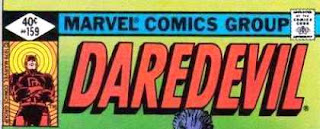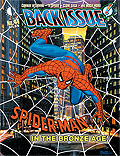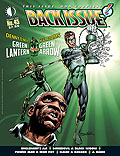Doug: Welcome back to our Bronze Age time capsule, effendi! This time 'round we're in the summer of 1979, perhaps the end of the period we love -- I know it was heading that way for me, as I'd be out of the hobby in about another year. One of the first things you may notice in this installment (today is the first of four) is the increase in cover price to 40c. You will see a 35-center here and there, but for the most part we little consumers were down to getting only two books for a buck. This was sad, as when I started in this I could get four for a dollar (and I believe Miss Karen could have gotten 5 -- gadzooks!!). Marvel Comics published 36 comic books and Marvel magazines, and I decided to delve into the month of July to pick up a couple of bi-monthlies like Daredevil. You'll also notice that the reprint titles are down to Marvel Tales and Sgt. Fury and His Howling Commandos -- no more Marvel's Greatest Comics nor any of the "split books" like Marvel Double Feature. Lastly, as we go through, be aware of the low issue numbers on many of the books -- this was a time of expansion, yet I think you'll see that of the books with the low numbers, few would survive much into the next decade. Oh, and a post script to "lastly" -- lots and lots of licensed titles are in this batch, perhaps indicative of where Marvel was creatively (?). So scroll down, and leave a comment when you feel moved.
Doug: Pretty safe here -- while the artwork on the corner box may be by a different artist (can't be certain), it remains the same pose. Note that the logo continues the less-detailed webbing that we'd seen on the book for the past 40-50 issues.
Doug: Our first look at a licensed title. Of course Battlestar Galactica attempted to capitalize on the Star Wars craze (The Empire Strikes Back wouldn't be out until 1980), and was a staple on my television each week!
Doug: Other than the Kirby art for the corner box, this logo remains the same as it had been for years. I still think this is one of Marvel's best-rendered logos.
Doug: This, too, remains exactly as it did when last we looked, back in 1976.
Doug: Crazy is our first look at Marvel Magazines. The Spidey logo at top left was prevalent on many of the PG mags, like Pizzazz, Marvel Super Special, etc. The PG-13 books like Savage Sword of Conan (coming up in a later installment) did not bear that logo. I was not a regular partaker of Crazy, but I did read a few.
Doug: Try this on for size -- as the most critically-acclaimed run in the title's history was beginning, Daredevil was a bi-monthly mag! I guess putting Frank Miller on it was a winner, because the character's still kicking after all these years. What a great series of stories.
Doug: Wow, am I glad this is cropped so you don't have to look at the rest of the cover art. You know, several weeks ago we discussed what was so great about the Bronze Age, the parameters timewise for a book to be considered Bronze Age, etc. I think I can firmly say that those who make a case for 1979 as the end can point to the artists who came on board as the '80's approached. The so-called (by me) "Al Milgrom school" was beginning to rear its ugly head, and this cover is an example (there are more coming -- look 'em up if you don't believe me!). Of note here is the absence of Dr. Strange in the corner box and the addition of Hellcat (by George Perez no less!).
Doug: Speaking of the good doctor, here he is and nothing's changed since 1976. Next!

























































6 comments:
You consider 1979 to be the end of the Bronze Age? I've read 85-86 as more commonly referred to ending points, and I'd have to agree (perhaps using Crisis On Infinite Earths and the general revitalization of DC with that, Watchmen, Dark Knight, and others as a marker).
Forgive my ignorance,but could you elaborate on what you mean by "the Al Milgrom School" of artists? Do you mean the next wave of artists was inferior,or trying to hard to emulated earlier artists? Just curious,thanks(and yes,I know who Milgrom is/was).
Some replies:
MaGnUs -- I don't necessarily consider 1979 to be the end of the Bronze Age, typically zeroing in on the specific books you cite as my more standard measuring stick. However, points were made in earlier Forums that (perhaps specifically at Marvel) one could choose 1979-80 as a dividing line between the characteristics of the post-Lee/Kirby et al. Marvel Age of Comics and the what came after that post-era (specifically, the direct market, limited series, company-wide crossovers, etc.). Looking through that lens, I can go with 1979-80.
However, if I factor DC into the mix, then the books you cite would definitely push my date back further. So, while I am still waffling on how I want to view this, the "1979" remark I made was a deference to comments made earlier, and was Marvelcentric.
J.A.-- I have long expressed my disdain for the art of one Al Milgrom, most recently on the message boards over at avengersassemble.us. Milgrom, while perhaps a good editor, never (ever) appealed to me as a penciller nor as an inker. It is very difficult for me to put my finger on just what it is about his work -- maybe it's too stiff, perhaps the postures he draws characters in seem a bit off, maybe it's the faces... I'm thinking it's an extreme case of "all of the above".
My snide comment about the "Al Milgrom School" brings in other artists who worked at Marvel and DC in the early 1980's who showed the same style (that I personally find unappealing) -- Richard Howell would be one example (see Vision and Scarlet Witch limited, volume II), and I'll admit that off the top of my head no other names come to me. So that's what I meant -- it was a knock that cast a very wide umbrella over the industry at that time.
Which is certainly not to say that there was no talent or no new good talent in that era. There was. If you want to know specifically what I meant, check out the full version of that Defenders cover.
Hope that helps, and thanks to both of you for the comments!
Have a great day,
Doug
That makes sense, Doug.
Interesting how you mentioned the summer of '79 as sort a personal "end of era" for you. For me, 1979 was roughly when the comics bug really hit me - it was about then that I really started following a number of series regularly rather than just "sampling" a few issues here and there.
By the way, re: the endless debate about the terminal points of the Bronze Age. I personally think Marvel started to move out of the Bronze Age by 1980. As you noted, Frank Miller gradually taking over Daredevil marked the beginning of something new. Also, as you noted, it was around 1980 that the entire market started to change - personally, I saw the appearance of the now unfortunately defunct Pacific Comics as a harbinger of change.
As for Milgrom, I agree with you on his art: never liked it, probably never will. But I have tons of respect for Milgrom the editor, and if nothing else, he deserves heaps of praise for the Marvel Fanfare series, which I enjoyed immensely.
If you consider the direct market, limited series, company-wide crossovers to be some of the markers of the end of the Marvel Bronze Age, I don't think the limited series and company-wide crossovers realy got underway until Contest of the Champions in 1982, and the direct market didn't really start until 1982, or late 1981, I think. Anyway, I agree with Magnus. I'll go with the 85-86 marker, especially as I really got into comics around 1978 or '79. I would also consider the Roger Stern Avengers comics to be Bronze Age, and he was on the book until 1987. Oh well, the end of the Bronze Age will always be fuzzy.
Post a Comment